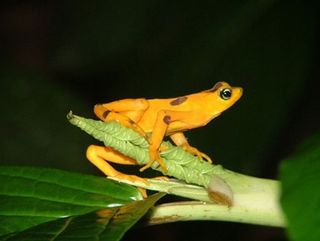Frogs More Abundant, But Disappearing Fast

Twice as many frog species may be hopping around in the Amazon as scientists previously thought, a new estimate suggests, but these amphibians are disappearing—fast.
Researchers from France and New Zealand collected and examined more than 500 DNA sequences from frogs in the Guiana Shield, which harbors the world's largest continuous tract of virgin tropical rainforest, running through French Guiana, Suriname, Guyana, eastern Venezuela and northern Brazil.
The DNA samples, including those from 60 previously recognized species, revealed an astonishing amphibian diversity, suggesting that the number of species identified in this study, detailed in the online journal PLoS ONE, is potentially two times greater than was previously thought to exist in the area.
Though scientists always thought more frog species existed in such dense tropical areas, the result of this study is still surprising, said herpetologist Karen Lips of Southern Illinois University, who was not affiliated with the study.
The work of other scientists has also pointed out how little we know about the number of species sharing the planet, especially smaller organisms.
This new finding highlights the need to better protect biodiversity, the authors say, as amphibians all over the planet are highly threatened by habitat destruction, climate change and a deadly fungus that has wiped out entire amphibian communities in Central America. Some species likely disappeared before they could be discovered, researchers say.
It is thought that more than 100 amphibian species have died out in just the last 30 years.
Sign up for the Live Science daily newsletter now
Get the world’s most fascinating discoveries delivered straight to your inbox.
"Given the unique evolutionary history of the Guiana Shield region, and its nearly pristine condition, it is critical that there is greater understanding of its frog species," said study author Antoine Fouquet, a graduate student at the University of Canterbury in New Zealand.
DNA analysis such as the one done in this study may become critical to saving imperiled frog species, Lips said, as it can help identify new species in areas that are threatened by the fungus so that they can be saved before they die off.
"This is a really important technique with the speed at which were losing these species," Lips said.
- Top 10 Surprising Results of Global Warming
- Images: New Amphibian Tree of Life
- How Many Species Exist on Earth?

Andrea Thompson is an associate editor at Scientific American, where she covers sustainability, energy and the environment. Prior to that, she was a senior writer covering climate science at Climate Central and a reporter and editor at Live Science, where she primarily covered Earth science and the environment. She holds a graduate degree in science health and environmental reporting from New York University, as well as a bachelor of science and and masters of science in atmospheric chemistry from the Georgia Institute of Technology.
